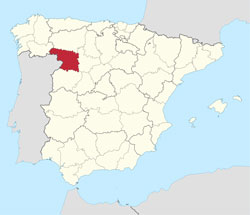Zamora in Zamora

The province of Zamora is situated in the north-eastern part of Castilla y León. It borders on the provinces of León, Valladolid and Salamanca and, to the west, the region of Galicia and Portugal.
With its 10,560 km2, it represents 2.1% of the surface of Spain, whereas the population of 170,588 represents only 0.36% of the total population of Spain. The population density of Zamora is just 16.15 souls per km2 compared to the national average of 94.
The province is divided up into 248 municipalities, and more than half of these have less than 250 inhabitants. In fact, only 15 municipalities have over 1,000 inhabitants, and just three more than 5,000.
 The highest point in Zamora is Peña Trevinca in the extreme northeast of the province at 2,127m above sea level, and the lowest in the township of Fermoselle at 330m above sea level
The highest point in Zamora is Peña Trevinca in the extreme northeast of the province at 2,127m above sea level, and the lowest in the township of Fermoselle at 330m above sea level
Zamora is also home to the Sierra de la Culebra hunting reserve which boasts large numbers of deer and wild boar as well as Spain’s most numerous population of the Iberian wolf.
The capital of Zamora is Zamora The city is situated centrally in the province at a height of 652m above sea level, which makes it the lowest capital of the region of Castilla y León. The population of Zamora does not quite reach 61,000, which places it as Spain’s 7th least populated capital.It is rich in history and historic monuments.
The old quarter has been denominated of historic-artistic value since 1973. In the heart of this is the historic centre, which is an elongated area, almost completely surrounded by the old city walls. It is situated on a rocky mesa, over 26 meters high, which borders on the Duero River. The Duero River runs through the city from east to west, dominating the cityscape.
One of the city’s most important features is its range of Romanesque buildings which are spread all over the city and represented by no less than 23 churches; 14 of these can be found in the historic centre.
This Romanesque heritage also includes a castle, the city walls, a bridge, two palaces and nine houses, as well as the cathedral. The city of Zamora is, not without reason, called the Romanesque City.
There are eleven Romanesque cathedrals in Castilla y León, and the Cathedral of Zamora is distinguished by being the oldest and the smallest. Zamora was the first city in the world to have global Wi-Fi cover, and it received the title Zamora Hot City (the Nobel Prize of informatics), although the cover left a lot to be desired and finally disappeared altogether and left about 1,500 users without cover.
The climate in Zamora can be described as a steppe climate, with scarce rain which falls mainly in autumn and spring, cold winters, and hot summers with minimal or no rainfall. The winters often see days on end of mist caused by the Duero River, which reduces the temperature even more.
The Easter Processions of Zamora are considered amongst the most important and spectacular in all of Spain. The ‘Procesión del Yacente’ is often placed at the top of the list for Spanish Easter processions; only the distant bells from the church and the sound of the torch ends striking the ground break the silence as this solemn procession passes through the streets of the city to Plaza de Viriato where it ends with a poignant rendition of the Miserere.
Zamora is well visited by tourists; however, the majority of these consider it a place to pass through on the way to or from somewhere else, and only about half of the visitors actually spend one or more nights in the city. 80% of the tourists come from Spain, mainly Madrid, Catalonia, and the Basque Country.


